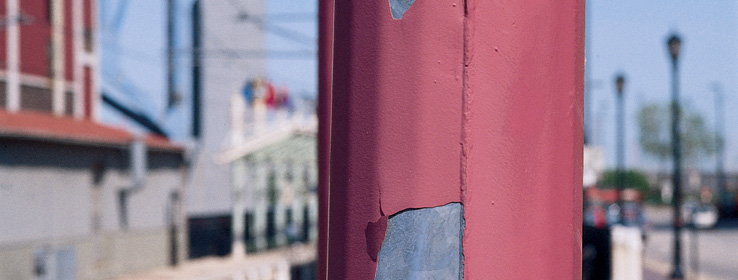DESCRIPTION
Paint that has lost its adhesion to a galvanized metal substrate (e.g. the surface that has been painted).
POSSIBLE CAUSE
New galvanized metal, a product used to make corrugated sheets, gutters, and downspouts, is usually smooth and is coated with either a layer of oil to prevent white rust or is passivated. Paint applied over this oily surface or clear passivator will peel quickly.
Alkyd/oil paints that are applied to galvanized metal will adhere initially, but will quickly fail. The zinc of the galvanizing will chemically react with the alkyd binder of the paint, creating a "soapy" film (saponification) on the galvanized metal and causing the coating to peel.
When unpainted galvanized metal is exposed to the atmosphere and allowed to weather without being painted and is exposed to the atmosphere, the protective zinc coating will oxidize into a white rust until eventually the zinc metal is depleted. The underlying steel will then rust.
When new, this oily/passivated galvanized metal is painted during cold or highly humid conditions, the curing of the paint film is retarded, resulting in wrinkling and loss of adhesion.
SOLUTION
The galvanized metal's protective layer of oil / passivator must be completely removed. Typically cleaning with a water-soluble cleaning agent will remove the oily residue. However, the passivator is not affected or removed using such cleaners. This can be easily confirmed by cleaning a small test area with a water-based or solvent-based cleaner. Once that area is dry, test the clean galvanized area with a copper sulfate solution. If the galvanized surface does not turn black, the passivator remains on the surface. This must be removed by SSPC-SP7 in order to coat the substrate.
Most hydrocarbon solvents, including mineral spirits, leave a thin layer of residue that leads to adhesion failure of the paint film. Instead, use a water-based cleaner/degreaser to clean a galvanized surface. Most acrylic coatings will adhere directly to cleaned galvanized metal.
A weathered galvanized surface develops a layer of white rust, which must be removed to ensure good adhesion of the coating. Wire brushing or scrubbing with a stiff brush or abrasive pad is recommended to remove the white rust.
Remove iron rust by wire brushing, sanding, or other abrading method; prime bare steel the same day it is cleaned. Severely rusted gutters should be replaced.
Test the coating in a 6" to 12" radius around any peeled areas to be sure the adhesion is adequate.
INTERIOR
Primer
(if needed)
All Surface Enamel Latex Primer
Pro Industrial™ Pro-Cryl® Universal Primer
DTM Primer/Finish
DTM Wash Primer
Suggested Finish
Duration Home®
Cashmere®
SuperPaint®
ProClassic®
EXTERIOR
Primer
(if needed)
All Surface Enamel Latex Primer
Pro Industrial™ Pro-Cryl® Universal Acrylic Primer
DTM Primer/Finish
DTM Wash Primer
Suggested Finish
Duration®
SuperPaint®
A-100®
WoodScapes®




